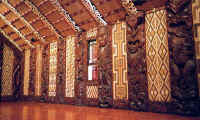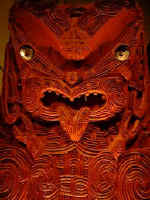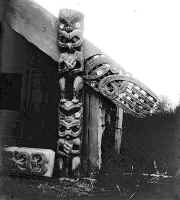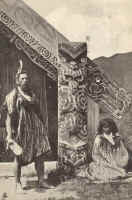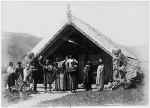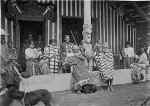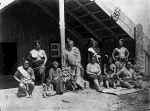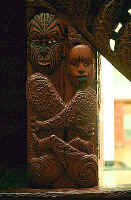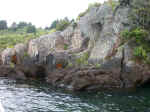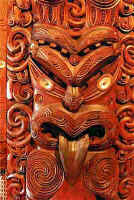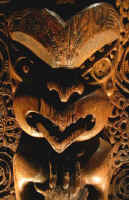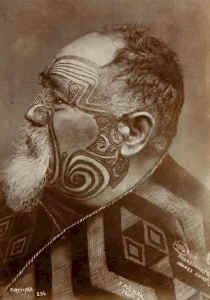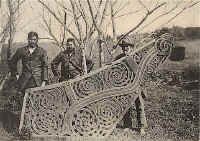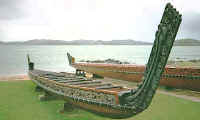|
It
is sometimes assumed that every cut in a piece of Maori carving must have a
meaning, but in fact probably much of it is purely decorative. The number of carvers of the nineteenth century who had been taught by pre-European experts makes it highly probable that most of the teachers' knowledge was passed on to the pupils.
There is no convincing evidence that the knowledge was too sacred to be handed on, as much information about equally sacred matters was revealed even to Europeans in the early days of the European settlement. It is a reasonable conclusion, therefore, that either the amount of symbolism in carving has been greatly exaggerated or that it had been lost by the time the Europeans came to New Zealand. Symbolic Carving on Maori Meeting HousesThe large carved meeting house (whare runanga) was usually named after an important ancestor and, in most parts of the country, was a symbol of that ancestor. The front of a carved house has at the apex of the gable a large carved head with no part of the body visible. This head is known as the koruru or parata. In old houses, it is actually carved on the projecting end of the ridgepole (tahuhu), and the body of the figure can be seen on the ridgepole inside the porch of the house. However, the house itself also represents the body of the koruru, who is the ancestor after whom the house is named. The arms of the koruru are the maihi or sloping bargeboards. At the lower ends of the maihi, which project beyond the upright figures (amo) on each side of the front of the house, is an open-work design with three, four, or five ribs running parallel to one another. Usually there is a manaia head between the ribs and the amo. The ribs are fingers, and they and the manaia represent the hands of the ancestor. It is a very common convention to use a manaia head on the hand of a carved figure. The ridgepole of the house represents the ancestor's backbone, and the rafters (heke) represent his ribs. The inside of the house represents the stomach or bosom (poho). This explains the common practice in the Gisborne and Hawke's Bay area of naming a house "Te Poho o xxxxx", where xxxxx is an ancestor's name, as in "Te Poho o Kahungunu" and "Te Poho o Rukupo".
A glance through the illustrations in W. J. Phillipps's "Carved Houses of the Western and Northern Areas of New Zealand" will show that the Waikato district is exceptional in that its early houses do not have the hands at the ends of the
maihi. Instead, there are open-work spirals similar to those carved on the lower ends of the maihi on smaller storehouses. It appears, therefore, that the Waikato people did not observe the usual symbolic form of the house. Symbolism in Maori StorehousesIt is common for the bargeboards of a large storehouse to depict a number of men hauling a whale ashore. The uppermost figure holds the tail of the whale and appears to be presenting it to the chief, represented by the tekoteko, the carved figure at the apex of the building. Why the whale is there nobody knows, but it is a reasonable assumption that the whale, representing a huge single amount of food, would be a most appropriate symbol of plenty to place upon a storehouse. Another feature seen on storehouses is an embracing pair of human figures, one male and one female. Usually the figures have naturalistic heads and are tattooed, but some with grotesque heads are known. Of 10 storehouses with a pair of figures, seven have this feature on the amo, or upright slabs beneath the maihi. The other three have the embracing pair carved above the doorway. Seven of these storehouses are from the Rotorua – Bay of Plenty area and the others are figured in sketches of North Auckland buildings drawn by Augustus Earle in 1827. These northern pataka have the typical designs of the Rotorua – Bay of Plenty area and were probably carved by experts from there. Captain Cruise recorded that when he was in the Bay of Islands in 1820 a pataka was being carved by a man who had been brought all the way from Thames to do this work. The embracing pair are sometimes said to represent the primeval parents of all living things, Rangi and Papa, the sky-father and the earth-mother. It is a reasonable supposition that there is a certain element of fertility symbolised by the figures on storehouses The Lizard in Maori artIn a monograph by Elsdon Best (N.Z. Journal of Science and Technology, Vol. V, p. 321), there are various illustrations of lizards in Maori carving. With two exceptions, all of the examples illustrated are Arawa work of the later nineteenth century. This does not mean, however, that the lizard is a post-European feature, especially in view of the continuous tradition of carving in the Arawa district. The carved house at the Spa Hotel, Taupo, was the work of Wero, one of the most outstanding carvers of Te Arawa in the middle of the nineteenth century and a pupil of other famous carvers. In this house a large lizard is superimposed on the body of the figure at the base of the
pou toko manawa, or central pole supporting the ridgepole. Two of the illustrations in Best's paper show lizards on ridgepole supports. This may be significant in view of Best's statement that a lizard was sometimes buried beneath one of the three posts supporting the ridgepole of a school of learning or other important building, the lizard being generally viewed as an effective guardian. Two of the examples figured by Best show a lizard on the
koruru head at the gable of a house. Hochstetter saw a lizard carved on the gable of a house when he visited Ohinemutu in 1859. It is worth repeating that the human figure was the basic design of the Maori carver, and when he was decorating objects, such as feather boxes, he used this basic design and probably had no thought of symbolism. It is interesting to observe that on these lesser objects the human figures are very frequently female. This is possibly because of the lack of tapu associated with women.
The spiral in Maori artIn addition to their many forms used in surface decorations, spirals are an important element in relief carving. Maori spirals are almost always double, though single spirals are occasionally seen carved on stone objects. As the elements in relief carving consist almost entirely of human figures, apart from the spiral, Archey has put forward a theory that the spiral itself has evolved from interlocking manaia, or the interlocking mouths of manaia. It is true that there are numerous examples of openwork spirals which do consist of two interlocked manaia or interlocked manaia mouths, but whether the spiral gave rise to these forms or evolved from them is not known. The spiral was commonly a prominent feature of maori male face tattoo. The openwork spiral is known as pitau or takarangi. Such spirals do not stand alone, but are placed between human figures or between the heads of human figures. The finest spiral designs are those on the bow and stern ornaments of war canoes and on door lintels. Spirals are also used between full-faced figures or manaia on door posts, window frames, and on the lower edges of maihi or bargeboards on the front of carved houses. On war canoes and in some house carvings spaces between the two volutes of a spiral are cut right through the timber producing, in superior work, a lacelike effect. Almost every one starts in the centre with a pointed elliptical space, or with a letter S. Red Ochre - kokowaiMaori wood carving was often high-lighted with red ochre. The mythological
of the origin of this important colour is as follows. There was much blood shed during the separation of
Papa-tu-a-nuku (Earth) and Rangi-nui (Heaven), the primaeval parents. The blood of Rangi-nui is sometimes seen as a red glow in the sky. The Maori call it
papakura and they look to it for signs and omens. The blood of Papa-tu-a-nuku, the Mother Earth, flowed into the earth itself and became red clay. |
